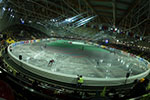The Moscow Ice Palace
Specialists from Johnson Control were faced with an Olympic-size undertaking – creating an ice rink, where future champions could train and compete for gold all year round.
DATE 2023-11-28 AUTHOR Maria LevitovIt may seem like there is no shortage of ice in the Russian capital, where thermometers plunge to -30°C, like clockwork, every winter. Few ice-skaters and sports fans, however, would let the 12,000 square metres ice at Moscow’s Ice Palace – the newest covered skating arena in the south-western district of Krylatskoye – go unnoticed.
This impressive arena, with the total area of 36,000 square metres was completed in September, 2004 and is currently Europe’s largest indoor ice rink. The Ice Palace – Russia’s most high-tech arena with advanced engineering systems from Johnson Control was built to house 8,000 spectators at a time.
And despite its relatively short history, this rink of Olympic proportions has already seen its fair share of breathtaking victories and mega sports stars.
World medallist figure skater, Maria Butyrskaya, has graced the arena with her jumps and loops. The blond bombshell now demonstrates her skills by training the most promising among the youngsters who are enrolled in her figure-skating school at the Ice Palace. Moscow Dynamo’s broad-shouldered bandy players, who prefer hockey with a ball to the traditional hockey with a puck, compete with other national bandy teams at the Ice Palace. Speed skaters also train there, striving to reach ever-faster results, in time for the next world championship or the Olympics.
Ice quality makes all the difference
Neither these athletes nor the amateurs, who come to the Ice Palace to skate to the latest tunes on the weekends, pay too much attention to the complex operations that go on behind the scenes at the rink. In fact, a small but highly trained army of Johnson Control's engineers works hard to ensure there is always smooth skating here, come rain or shine. Even when the bright July sun heats up the streets outside to a scorching +30°C, Johnson Control’s refrigeration system, complete with Alfa Laval’s plate heat exchangers, keeps the rink’s ice at its best.
“There is a direct link between the quality of ice and an athlete’s performance,” says Boris Vasilkovsky, Russia’s National Junior Speed Skating Team’s coach. He sternly peeks at the timer as a small group of crouching skaters makes another lap around the chilly arena.
Johnson Control has been installing ice and refrigeration systems around the world for more than a century, but the company’s work at Moscow’s Ice Palace is one of special responsibility because the difference between good ice and bad ice can translate into the difference between the bronze and the sought-after gold in an athlete’s life.
”I learn from the athletes about what makes good ice,” says Grigory Yakovlev, the Ice Palace’s Chief Heating and Air-Conditioning Expert.
Yakovlev’s team works with the specialists from Johnson Control – including Vladimir Tsarkov, Supervisor of the Refrigeration Department and Sergey Vyatkin, the Refrigeration Department’s Chief Design Engineer – to monitor and to tweak the ice conditions at the arena. They keep track of the skating conditions from the Ice Palace’s basement control room, using the same precision one would expect from a nuclear submarine crew.
“Figure skaters need a much softer ice than speed-skaters in order to perform at their best, while hockey players need something in between,” Vyatkin says. He has learned the ins and outs of ice sports, while working to make sure that dozens of chillers, compressors and air handlers that power the Ice Palace operate together smoothly.
Perfect control behind the scenes
A “weather station”, installed by Johnson Control, uses a wireless signal to transmit meteorological data – including humidity, air pressure, wind speed and temperature – to the basement control station. There, trained mechanics check the readings and adjust the ice conditions, tailoring them for each of the Ice Palace’s sports.
 “You need hard ice, which can help you run,” explains Irina Arshynova, 18, as she massages her impressive leg muscles after stepping off the ice. Arshynova knows what she is talking about because she has been cutting the ice for more than a decade, after stepping onto a rink in her native town of Chelyabinsk, in Russia’s North East. Despite her young age, Arshynova has trained on the best ice rinks in Europe and throughout Russia. She is looking forward to strutting her stuff at the junior speed skaters’ All- Russia championship, which will determine whether Arshynova will go on to skate at the world championship in Germany.
“You need hard ice, which can help you run,” explains Irina Arshynova, 18, as she massages her impressive leg muscles after stepping off the ice. Arshynova knows what she is talking about because she has been cutting the ice for more than a decade, after stepping onto a rink in her native town of Chelyabinsk, in Russia’s North East. Despite her young age, Arshynova has trained on the best ice rinks in Europe and throughout Russia. She is looking forward to strutting her stuff at the junior speed skaters’ All- Russia championship, which will determine whether Arshynova will go on to skate at the world championship in Germany.
The athlete says she prefers enclosed spaces, like Moscow’s Ice Palace in Krylatskoye, to open-air rinks, even to those that are located high in the picturesque mountains. ”Unpredictable weather, like a sudden gust of wind or sleet, can really knock you out at an open-air rink,” she says. “The conditions are much better in an enclosed arena, where the staff can control everything, right down to the density of ice. Instead of working against you,” Arshynova explains, “the hard ice gives enough resistance to allow the skates to push off it well, especially during the turns that can be quite treacherous.”
The bleachers behind her are empty at the moment, but Arshynova gives it her best during the training session, so that she can truly shine when noisy fans fill the seats.
When they come to the Ice Palace to cheer for their favourite athletes, the spectators will be sitting on top of more than a dozen Alfa Laval plate heat exchangers and other key parts in Johnson Control's building management system. All the technical gadgets, including the central control room, are hidden from sight in the nether regions of the rink, just below the bleachers.
Large responsibility
From time to time, Vyatkin and his colleagues venture out to this basement which to an untrained eye looks more like a military control centre in a James Bond movie, than a climate control area inside an ice skating rink. They look at the panels – the temperature reads -8°C on the outer loop, where the speed skaters train, and -6.5°C at the centre of the rink, roped off for figure skaters. Johnson Control's cooling centre makes it possible to freeze the whole ice rink at once, or to divide it into separate zones.
Undaunted by speed skaters who whiz past, Maria Butyrskaya shares the secrets of champions with her slim trainees. One by one, they skate by her at the centre of the rink, showing off breathtaking arabesques they have achieved with years of strict ballet training.
Johnson Control’s Vyatkin and Tsarkov admit that the refined beauty of figure skating is not for them. Tsarkov’s heart lies with hockey, while Vyatkin prefers skiing to any other winter sport. Nevertheless, the two say they feel a great weight on their shoulders when the Ice Palace hosts yet another high-profile event.
“You become a little nervous for the athletes; you just can’t help it,” Vyatkin says.
The Ice Palace has already hosted numerous speed skating championships and bandy games. The arena was especially designed to house these and other winter sports, including figure skating and curling.
Alfa Laval / Johnson Control cooperation
Alfa Laval supplied about a dozen plate heat exchangers for the high-tech refrigeration and air conditioning system which Johnson Control installed in Moscow’s Ice Palace.
The plate heat exchangers perform an essential task of churning out energy that is used by Johnson Control’s refrigeration system to make ice for the rink and to cool the arena when the weather warms up.
“We are happy with the overall performance of the plate heat exchangers,” says Sergey Vyatkin, Chief Design Engineer of the Refrigeration Department at Johnson Control Russia.
“Making all the different parts of our system work smoothly as one element is the biggest challenge in our work.”
Johnson Control’s system manages all the engineering systems at the Ice Palace, including the central air conditioning and the cooling centres for the ice rink. It also runs a special water preparation station to make high quality of ice, the exact temperature of which is then carefully monitored at various parts of the rink.
Johnson Control’s system prevents the mist from rising from the ice surface and controls the CO2 concentration at a permissible level. The company also installed 80 sensors inside the rink to provide information about the temperature at different levels inside the arena. Johnson Control’s wireless network for ice monitoring provides information about the ice conditions to the judges and referees during competitions in real time.
Tags
All
